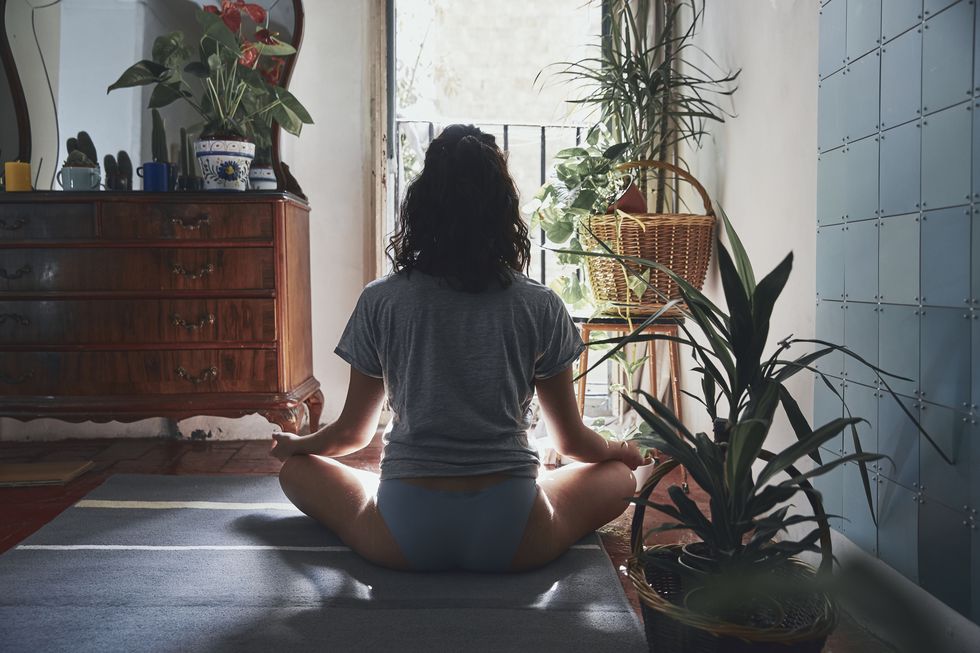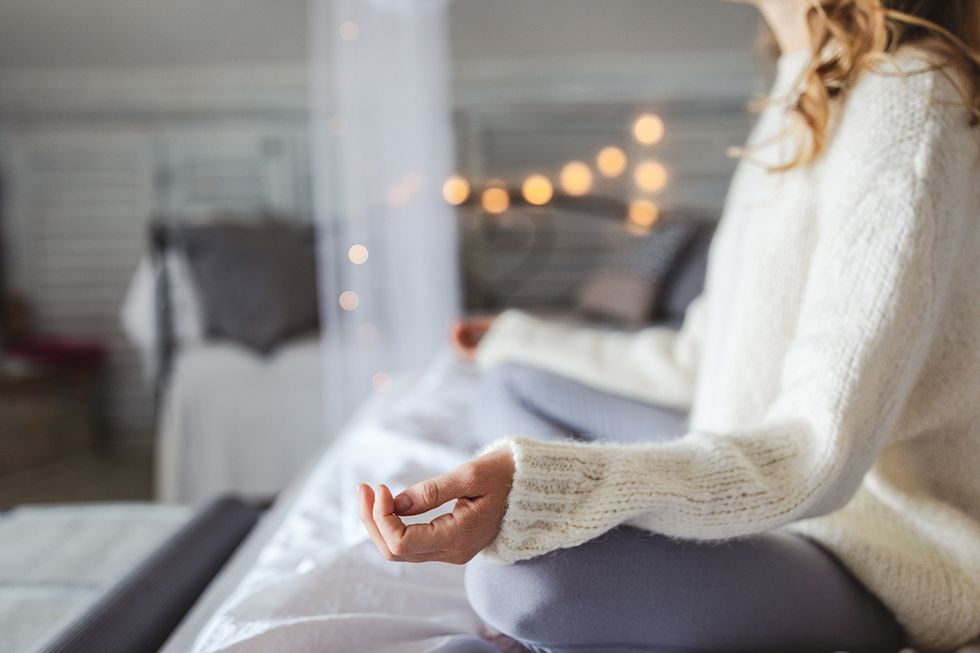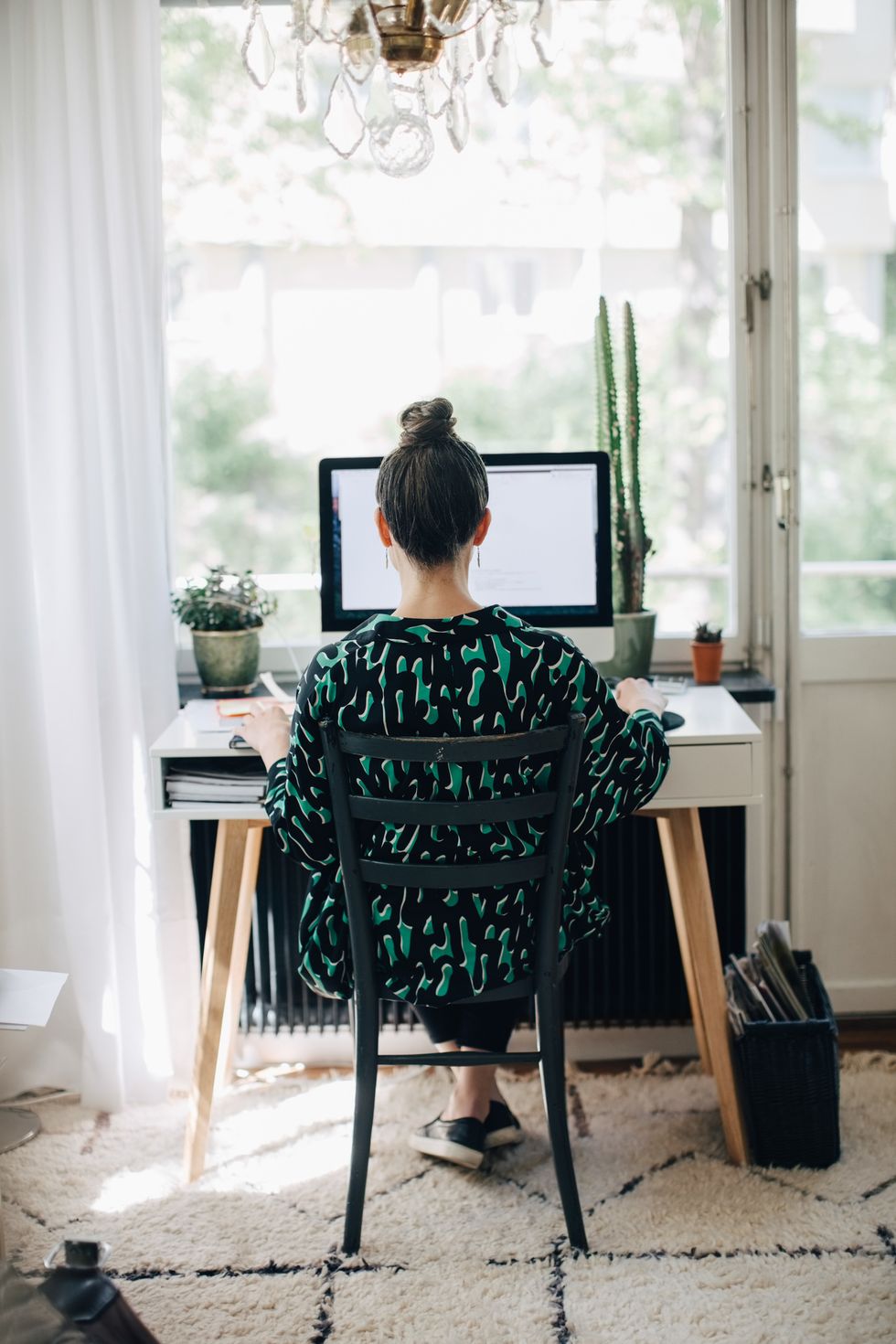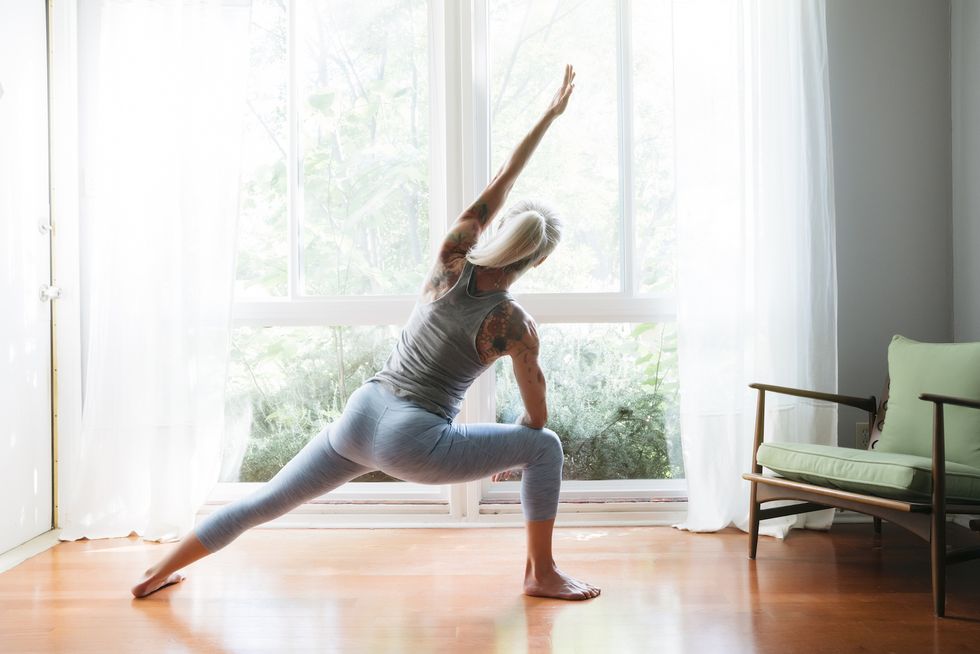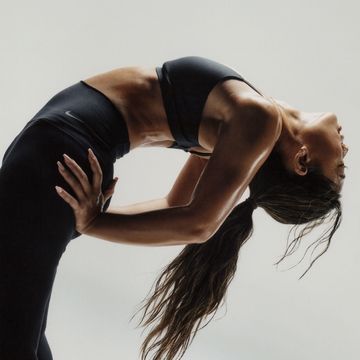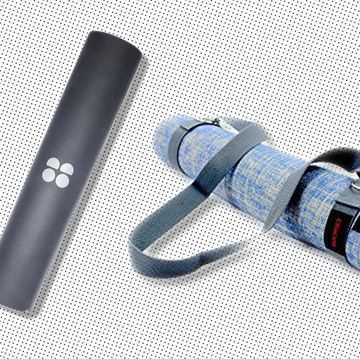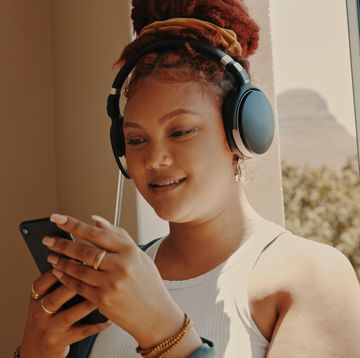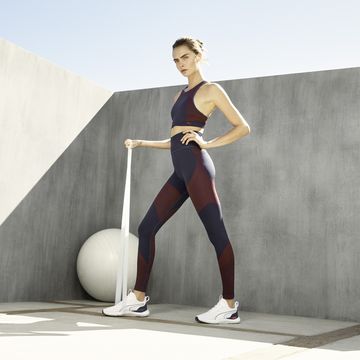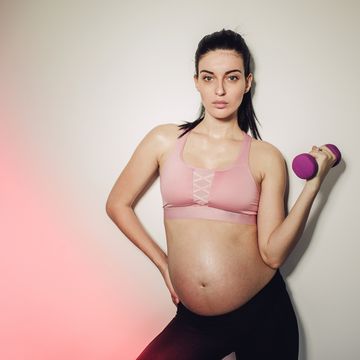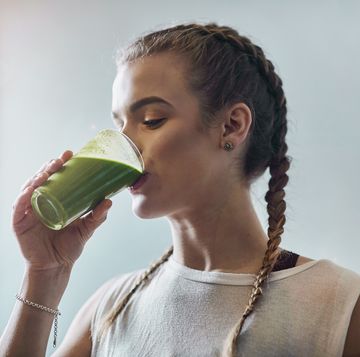If there’s one thing we’ve learned about working from home during the ongoing Covid-19 pandemic, (other than our worrying ability to finish a packet of Hobnobs in one sitting), it's that social distancing can prove challenging for both the body and the mind.
With limited social interaction, time outdoors and stints away from our make-shift desks, it’s imperative for people to prioritise staying active, but also to do things to ease stress and calm the mind.
According to the government's latest measures under Tier 5, people may now only leave home to exercise once a day, travel to and from work when it is ‘absolutely necessary’, meet a support or childcare bubble, shop for essential items and fulfil any medical or care needs.
Fortunately, yoga is the perfect way to alleviate tension before or after a long day at home, loosen up any niggles or aches in the body and also clear our heads and reset.
‘It allows us to calm the mind, to connect with the breath and body,’ yoga teacher and movement coach Kim Hartwell tells us. ‘Yoga teaches us how to be peaceful in our internal environment (the mind) while the external environment (for which we have little control) changes.’
We spoke to several experts to find out their advice on using yoga to calm our mind and soothe our body during otherwise turbulent times.
What simple yoga practices should we be implementing to start our days?
Waking up in the morning during the pandemic might often seem like a scene from Groundhog Day: get out of bed, shower, brush teeth, put kettle on, make breakfast sit down at desk for eight hours. Repeat. However, there are several ways you can start the day on a better and more even footing.
For yoga teacher Lydiana Abbott (@kuasayoga), she suggests implementing the breathing practices of yoga to start the day. ‘You can simply focus on your breath, seeing if you can create a slow and controlled rhythm. Especially focusing on lengthening the exhalation,’ she tells us.
Meanwhile, yoga teacher Georgia Wood (@backtoyouyoga) suggests starting each morning with a sun salutation – a means of honouring the sun through the dynamic asana sequence Surya Namaskar.
‘It warms up the body in a safe way and only take a few minutes,’ she says. ‘Make sure to do it before going into the deeper postures, especially in the morning when our bodies are tighter.’
Why is it important to make boundaries during self-isolation?
With seemingly endless hours to fill during the pandemic, it is often tempting to fall into bad habits.
Whether it’s working through lunch breaks, failing to get up and stand or walk around to warm up the muscles, forgetting to drink the NHS' recommended 1.2 litres of water a day, or typing away at laptops far beyond when our working day should finish.
‘With the lack of boundary between coming and going to a physical work space its common to let home turn into a place of constant work,’ says Hartwell.
That’s why it’s essential that we reclaim control and set certain limitations on our working hours to make sure we maintain a healthy psyche and body during social distancing.
‘By having a regime like going for walks, moving the body, connecting with friends and family (albeit virtually) it helps ensure that we still have the right amounts of work/life balance,’ she adds.
Wood goes further to emphasise the importance of recognising that this period of isolation during the pandemic isn't an excuse to work longer hours.
‘If we don’t create boundaries we might head towards burnout - especially while isolated,’ she says. ‘By setting a time to end your work and begin a short meditation or longer yoga practice, work and relaxation become much more distinct parts of your day.’
Why is it important to stop working and reset our bodies with yoga?
Whether you’re a well-versed yogi or someone who wants to develop a new skill during self-isolation, yoga is an ancient form of exercise that focuses on strength, flexibility and breathing to improve physical and mental wellbeing.
So, what better practice to incorporate into our days than right now?
Hartwell notes: ‘We already live in a western society of sitting down far more than is healthy for our bodies which has been compounded by the recent requirement to work from home where possible. When we sit for long periods of time our bodies become stagnant, the posterior chain (back of the body) becomes weak and “lazy”, the front side (anterior chain) becomes overused.’
In order to alleviate this pressure and that 3pm slump many of us are becoming accustomed to, Abbott suggests taking up an online midday yoga class.
‘It creates mental closure from the morning and sets you up nicely for the afternoon she says.
How often should we practice yoga?
Like most exercises, there isn’t a set number of times, repetitions or sets that the body requires to get fit as it entirely depends on how much time you can practically set aside for fitness and your body’s capability to work out.
As a result, it’s more important to listen to your body and ideally, as per the government’s instruction, get at least 30-minutes of active movement into your daily routine, whether that’s a run, jog or cycle outdoors or an home workout.
If you are new to yoga, Abbott suggests starting out with a practice once or twice a week.
‘I would recommend trying to do it for five weeks straight before deciding if it’s for you or not,’ she says. ‘If you are a regular practitioner, that’s for you to decide.’
Meanwhile, Wood suggests doing a short practice most mornings. ‘Three times a week is enough alongside other exercise,’ she says.
‘If you run, cycle or spend periods sitting down, yoga can be really important to stretch out your muscles (as well as strengthening them) and has huge benefits for your state of mind.’
What exercises should we prioritise when it comes to yoga and why?
Depending on your ability and flexibility, understanding what yoga exercises to practice will depending entirely on one’s own body.
However, there are certain moves that yoga experts suggest may help loosen up the body and mind.
For Abbott, she advises practicing the following three moves: eagle pose, tree pose, Savasana.
‘I have picked two balance poses and a resting pose,’ she explains. ‘I find a lot of grounding when practicing a balance. I feel truly connected to the ground beneath me and my surroundings. This feels like a priority at the moment especially when there is so much energetic chaos in the air.
‘Similarly, Savasana (the practice of gradually relaxing one body part at a time, one muscle at a time, and one thought at a time) also brings that sense of grounding and allows rest. Rest is all we need right now to be able to recover from this in every aspect of our lives.’
For those wanting slightly more movement, Wood suggests practicing cat, cow, butterfly and lizard.
Here’s a step-by-step guide on how to do them:
Cat, Cow: to provide movement in the spine and energy through the body
- Come to hands and knees.
- Inhale and lift your tailbone and the crown of your head, looking to the ceiling - arching the spine.
- Exhale and drop your head and tailbone, pushing up into your mid-back - rounding the spine.
- Repeat 5 times, moving with your breath.
Butterfly: to open the hips and release the lower back
- Sitting down, bring the soles of your feet together and let your knees fall out to the sides (you might like to sit on a cushion).
- By bringing your feet closer to you, you deepen the stretch in your groin (push feet away if this is too strong).
- Try not to round the spine; grow tall through your back.
- To go deeper, open your feet up like a book - this should bring your knees closer to the ground.
Lizard: to release tension in your hip flexor (front of your hip)
- From downward dog draw your right knee to your right elbow, step the foot outside the right hand.
- In this deep lunge, rock your body very slightly back and forth, releasing any tension in your right hamstring/left hip flexor.
- Stay here for a few breaths or if it’s available slowly come down onto both forearms (forearms can come to a thick book if they don’t reach the ground) and let your head be heavy, releasing the back of your neck.
- Repeat on the other side.
How can we ‘reset’ our minds during Covid-19?
An evidence review published in February 2020 on the psychological impact of quarantine found that if managed well, self-isolation need not lead to longer term mental health problems such as anxiety and depression.
The study, published in The Lancet, found that improved communication, adequate supplies and enough information helps people cope mentally during self-isolation.
However, there are a few measures we can do to keep our brains healthy and active.
‘This is the perfect opportunity to stop and reset without all the external influences like commuting to work and being interrupted by colleagues,’ says Hartwell.
‘Use it to prioritise time spent before and after work with the extra time you’re saving on the commute; walks in nature, meditation, journaling, movement will all go huge lengths to make you feel happier and healthier in this time.’
Meanwhile, Abbott suggests people follow a guided meditation with the help of apps like Headspace and the Yoga Nidra Network YouTube channel.
‘Or simply take three to five minutes focusing on your breath a few times a day,’ she says. ‘You can either schedule in this time, do it before/after you eat breakfast, lunch, dinner, or after you use the toilet. Close the seat, sit down and breathe...you will leave feeling refreshed!’
Wood advises taking just five minutes each morning to set an intention for the day.
‘Letting yourself have a mid-afternoon break and coming back to your intention - this can put things in perspective and improve your mood as well as focus for the rest of the day,’ she notes.
What are some apps or tutorials you advise people checking out for at-home yoga right now?
With gyms, fitness studios and yoga centres in the majority of the UK now closed under Tier 5 guidelines, many of us are turning to home workouts and apps where there are a plethora of virtual classes to replace in-person offerings.
While some of these classes are free, Hartwell points out that some are donation based which is a great way of supporting local and independent businesses as well as the self-employed during this time of financial uncertainty for some.
‘Many have no other source of income its kind to give what we can when taking them,’ says Hartwell.
‘My favourites are Richie Bostock aka @thebreathguy for breathwork, @celestpereira for fun, creative and super informative yoga flows, @daniellewillls for mobility, @belindaburwell and @phoebegreenacre for yoga and meditations,’ she notes.
Meanwhile, Abbott holds one free class a week and her online classes are also free/pay-what-you-can for self-employed and anyone else affected financially by the outbreak.
Wood is also livesteam classes on YouTube here and suggests checking out meditation apps such as Insight Timer and Calm.
What at-home items can we use to help us do yoga?
If you usually rely on your gym or studio’s yoga equipment such as blocks, belts, matts and eye pillows to aid your practice, then there are certain items around the house that you can use instead.
The experts agree that books work as excellent replacements for bricks and blocks, while ties, scarves and towels work as straps.
‘I like to have a cushion or folded blanket nearby to use as a prop (to sit on if you have lower back issues),’ says Wood.
Like this article? Sign up to our newsletter to get more articles like this delivered straight to your inbox.
In need of more inspiration and thoughtful journalism? Subscribe to ELLE's print magazine now and pay just £6 for 6 issues. SUBSCRIBE HERE

Katie O'Malley is the Site Director on ELLE UK. On a daily basis you’ll find Katie managing all digital workflow, editing site, video and newsletter content, liaising with commercial and sales teams on new partnerships and deals (eg Nike, Tiffany & Co., Cartier etc), implementing new digital strategies and compiling in-depth data traffic, SEO and ecomm reports. In addition to appearing on the radio and on TV, as well as interviewing everyone from Oprah Winfrey to Rishi Sunak PM, Katie enjoys writing about lifestyle, culture, wellness, fitness, fashion, and more.

